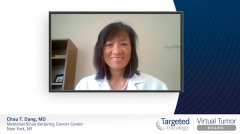
Case 1: Neoadjuvant Therapy for Early-Stage HER2+ BC
Centering discussion on a patient case of early-stage HER2+ breast cancer, expert oncologists consider when it is appropriate to utilize neoadjuvant therapy.
Episodes in this series

Transcript:
Sara A. Hurvitz, MD: Hello, and thank you for joining us for this Targeted Oncology Virtual Tumor Board©. Today, our discussion will focus on updates in the management of HER2-positive breast cancer. In today's presentation, my colleagues and I will review 2 or 3 clinical cases. We will discuss approaches to treating patients with HER2-positive breast cancer and will share our perspectives on key clinical trial data that may impact our decisions. I am Dr Sarah Hurvitz; I am a breast medical oncologist practicing at the University of California, Los Angeles. I am very pleased to be joined by Dr William Gradishar, chief of hematology and oncology in the Department of Medicine, Betsy Bramsen Professor of breast oncology and Professor of medicine at Northwestern Medicine, Medical school in Chicago. Dr Gradishar, thanks for being here.
William J. Gradishar, MD: Happy to be here. Thank you.
Sara A. Hurvitz, MD: And Dr Sara Tolaney, breast medical oncologist from Dana-Farber Cancer Institute in Boston. Thank you so much for being here, Dr Tolaney.
Sara M. Tolaney, MD, MPH: Thanks for having me.
Sara A. Hurvitz, MD: Let's get started. Our first case is going to be related to a patient with early-stage HER2-positive breast cancer. She is a 43-year-old woman who works full-time and has 2 young children, who presented with a palpable mass in the left breast. She had imaging done that revealed in the left lower outer quadrant a 2.2 cm mass. A breast MRI was done that confirmed a 2.2-cm mass plus a 0.7-cm mass at the 12 o'clock region, and an area of non-mass like enhancement extending between these 2 areas for a total area of 5.5 x 7 cm. Two regional lymph nodes did appear to be enlarged and abnormal. A biopsy of the 2.2 cm mass revealed ER (estrogen receptor)/PR (progesterone receptor)-negative HER2-positive or HER2-plus by IHC [immunohistochemistry] but FISH [fluorescence in situ hybridization]-positive for amplification with a ratio of 3.8 and a copy number of 6. The Ki-67 was 35%, and a lymph node biopsy was positive for metastasis. She did also have a biopsy of the 12 o'clock lesion which showed the same histology breast cancer as well as DCIS [ductal carcinoma in situ]. She was clinically staged as cT2N1M0, Grade 3, Stage 2b. What I want to do now is pick your brains and understand how you assess a patient initially diagnosed with what appears to be early-stage HER2-positive breast cancer. Let's assume for this case that the patient had a work-up that ruled out any clinical evidence of distant metastases. In this type of situation where a patient does have a tumor size greater than 2 cm and nodal positivity, how do you assess what treatment you want to give in terms of neoadjuvant versus adjuvant treatment? Sara, can you give us a broad-strokes overview of how you would begin to assess her risk and develop a treatment plan?
Sara M. Tolaney, MD, MPH: We've really moved towards predominantly using preoperative therapy for HER2-positive patients. The general idea behind it is that it allows you to downstage the tumor, which can make surgery easier. Potentially more important is the ability to understand how sensitive that tumor is to therapy, assess its response, and be able to adapt your therapy based on that response to treatment. That has dramatically changed outcomes for people being able to adapt treatment based on achievement of pCR [pathological complete response] or not. In general, if someone has a node-positive cancer such as the patient in this case, or if someone has a tumor that in general is 2 cm or greater, my general approach is to give preoperative anti-HER2–driven therapy.
Sara A. Hurvitz, MD: That sounds great, and I completely agree with you. What about you, Bill? How would you assess this patient’s risk, and what approach would you take in initial management?
William J. Gradishar, MD: Back to basics. This patient has what might be viewed as somewhat higher volume of disease based on the tumor size and nodal involvement. This is somebody about whom we would be concerned about the prognosis being somewhat higher or worse than somebody with no negative disease. In such a patient, not unlike what both you and Sara have already mentioned, we would be more inclined to use preoperative therapy; we've now seen with the introduction of new drugs and strategies that we can really crank up the number of patients who at the time of surgery have no evidence of disease, but equally important, we’ve found that translates into better event-free survival. I think these strategies have evolved, and as Sara [Tolaney] from the East Coast was saying, we now have an approach where we can think about tailoring the therapy depending on what the response is. A lot of the focus of clinical trials that are now underway are this adaptive response modeling, where if you have a very good response versus perhaps having residual disease, the therapy postoperatively may change. I think all this information is really a consequence of all the trials that we use now as standard therapies in clinical practice.
Sara A. Hurvitz, MD: Excellent. I couldn't agree more. Sara, can you talk to me about who you choose for neoadjuvant therapy? Is there anyone in whom you feel it's inappropriate to start with systemic therapy?
Sara M. Tolaney, MD, MPH: I tend to be a little bit biased; if someone has a stage 1 cancer, I usually want to confirm that at times surgery to know that I can give them less therapy. For most of my node-positive patients or someone who has a tumor that's over 2 cm, I'm generally giving TCHP [Taxotere® (docetaxel) + carboplatin + Herceptin (trastuzumab) + Perjeta(pertuzumab)] preoperatively, usually for 6 cycles, and then taking them to surgery. Let's say someone presented with an 0.8 cm cancer with clinically no palpable node seen, I do generally take that person to upfront surgery to confirm their stage 1. Then, if so, they can get away with less therapy, and usually I think of something like TH [paclitaxel and trastuzumab] or T-DM1 [trastuzumab emtansine] in that patient. Confirming that they’re stage 1 in my mind is important—to know that I can get away with less. I think where we're struggling a bit with right now is this in-between zone. If someone has a 1.8 cm cancer, I just said they didn't quite meet my 2-cm algorithm. They're not clinically node positive; what are you going to do about them? I do feel like it may not be the best thing for that patient;for example, if we take them to surgery and find that they actually had more cancer than I thought. Maybe they had a positive node or maybe their tumor’s bigger; I've missed out on the opportunity to have given them preoperative treatment. Then, as Bill was saying, it was so critical to be able to adapt therapy based on response to improve EFS [event-free survival]. Now, I'm not going to know what that response is because I just took him to surgery and I'm giving the management systemic therapy. I think this is where we're struggling a little bit now. Our group has actually taken the stance that for anyone who has a clinical stage 1 cancer, we do need to get an x-ray ultrasound up-front. It turns out in a series that we did, about 10% to 15% of patients who appear to be clinically N0 with a T1c tumor actually do have nodal involvement. Being able to know that up-front in catching many of them by x-ray ultrasound would be important so that you don't just take that person straight to surgery.
Sara A. Hurvitz, MD: It's interesting that you're using axillary ultrasounds in this way. I think looking at the size of the tumor to help gauge whether or not you should go to surgery first and not overtreat...Bill, are you ever using neoadjuvant therapy for patients with smaller tumors? Are you looking at biological features, patient age, lack of hormone receptor expression, grade of the tumor? Do these things ever impact you choosing a neoadjuvant approach, and maybe a smaller tumor type?
William J. Gradishar, MD: I don't know that my thinking is so much different than Sara's. I think as the tumor gets closer to 2 cm...I don't know that there's something magic about 1.6 and 1.8, but as the closer it gets to that 2-cm mark—acknowledging that imaging is not always accurate for the actual dimensions of the tumor—the more likely we are to give neoadjuvant therapy. That said, not unlike Sara, we have tumors that are closer to 1 cm, and I'm going to take or recommend that those patients go to surgery first for the exact same reason that Sara said. Those are people where they may not have to experience the toxicity of a more involved regimen and have an outcome that is equally good.
Transcript edited for clarity.












































